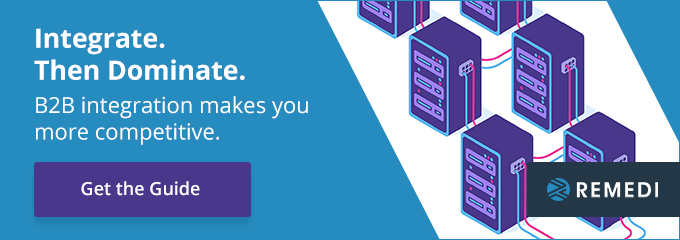
You use B2B integration solutions on a day-to-day basis to share information with your trading partners, yet have you ever considered integration as a business model? B2B integration enables accurate, real-time information transfer between trading partners for greater efficiency, lower risk, and cost savings.
What Is B2B Integration as a Business Model?
To understand the concept of B2B integration as a business model, let’s take a look at the way companies run today. The phrase “no man is an island” has never been more true, especially in the business landscape. Instead, companies are part of a global ecosystem.
For that ecosystem to function properly, companies must exchange information with one another. Moreover, that exchange must happen quickly; your trading partners are most likely located across the globe, and if there’s a flood at a factory in Vietnam, you can’t wait until you hear about it on the evening news.
“Companies are part of a global ecosystem, which requires real-time information transfer.”
That’s where B2B integration comes in. It shares information between businesses in a network so that everyone has visibility into the supply chain. So what does it mean to utilize B2B integration as a business model, though?
Your business model is your core strategy for making a profit. When you make B2B integration your business model, you’re relying on that technology to make your company more profitable. You’re making supply chain digitization the backbone of your business, regardless of which industry you’re in.
What is a B2B Integration Platform?
A B2B (Business-to-business) integration platform that enables businesses to seamlessly exchange information. B2B integration platforms help to streamline business processes and improve collaboration by facilitating data exchange between a company and their partners, suppliers, and customers.
Features of B2B integration platforms include:
- Automation
- The platforms allow automation of business processes resulting in reduced manual work and fewer errors.
- Data transformation
- The platforms are able to convert data between different formats so that systems on each side of a transaction can read the data even if they use a different protocol than the other side.
- Scalability
- The platforms adjust to the needs of the businesses that use them by maintaining high performance even when transaction volumes are increasing.
- Monitoring
- Businesses can use the dashboards and reporting tools in B2B integration platforms to gain insights into transactions and monitor performance and intervene immediately as needed.
- Communication Protocols
- Compatibility issues are eliminated due to support for multiple communication protocols including HTTP, ASP, FTP, and SFTP.
- Compliance and Security
- Security features allow businesses to meet regulatory requirements. Data is protected at rest and in transit.
IBM Sterling B2B Integrator is a notable example of a B2B integration solution. This robust platform is able to support complex B2B/EDI processes while offering a high level of customization.
The Benefits of B2B Integration
Utilizing B2B integration in your business has several benefits:
- Greater levels of digitization boost fill rates by 80%
- Shortened cash-to-cash cycles, which led to greater profitability for75% of companies
- Higher annual growth of earnings before interest and taxes (3.2%) and higher annual revenue growth (2.3%)
Four Components of a B2B Integration
In order for organizations to exchange business information between different systems, it’s helpful to take a look at the four components of the underlying process: Source Application, Data Format, Transport Protocol, and Target Application.
- Source Application: The B2B integration process begins with the source application, which initiates data exchange by preparing the data and converting it to a structured format that is readable by the recipient system. The data sent might come from any of the following systems:
- Enterprise Resource Planning System (ERP)
- Customer Relationship Management tool (CRM)
- Various databases or other applications specific to the business
- Data Format: The source application will structure and encode the data in a specific, previously agreed-upon format such as XML, JSON, EDIFACT, or X12.
- Transport Protocol: This method defines how data will be transmitted between the source and target. Transport protocols used could include HTTP/HTTPS, FTP, SFTP, and AS2.
- Target Application: This is the final destination for the data that is transferred. It could be the receiving company’s CRM or ERP system. The target application will convert the data into a format readable and compatible with the system’s internal processes.
Getting Started with B2B Integration as a Business Model
You’ve already implemented a B2B integration suite – what’s the next step in making it your business model?
It doesn’t mean that you’re switching core competencies. For example, suppose you’re in the automotive industry, and you want to make B2B integration your business model. In that case, you’re not going to move into B2B integration consulting suddenly. Instead, you’re going to leverage B2B integration to become more profitable.
“Leverage B2B integration to become more profitable.”
Here’s how you can do that:
- Use real-time visibility into your supply chain to mitigate risks
- Onboard trading partners faster
- Reduce penalties such as chargebacks
- Stay competitive and agile
Use Real-Time Visibility into Your Supply Chain to Mitigate Risks
One of the benefits of B2B integration is that it provides real-time visibility into your supply chain. That knowledge helps you reduce risks to your business.
We’ll illustrate with an example. Let’s say you’ve got a factory in Malaysia, and weather predictions show a tropical storm is headed in that direction. The tropical storm could injure or kill workers as well as knocking out electricity.
“B2B integration provides real-time visibility into your supply chain, which helps you mitigate risks."

With that knowledge, you can search for another supplier in a less risky location. You avoid delays due to factory closures, so you can continue meeting customer demand.
Onboard Trading Partners Faster
Take a moment to think about the last time you brought a new trading partner on board (or if you were brought on board as a trading partner at another firm). How long was the process? Was it smooth and seamless?
At many large firms, it can take between three to six months to onboard supply chain partners. Several internal functions, including Legal, Procurement, and Compliance, are involved in reducing the risk. Yet, during this time, the partner’s factory workers could go on strike, a piece of vital equipment could shut down, or they could accept a much larger order that takes up all of their capacity. If that happens, you have to start the selection and onboarding process from scratch.
“Onboarding can take between three and six months at large firms.”
B2B integration shortens partner onboarding without increasing the risk or creating compliance or legal issues. As a result, you can start working with partners faster; for customers, you get your supplies sooner, and for suppliers, you get paid quicker.
Reduce Penalties Such as Chargebacks
When you don’t fulfill a customer’s order correctly or don’t uphold SLAs, you’ll see chargebacks. They’re an irritating, expensive part of doing business…except they don’t have to be.
B2B integration suites draw information directly from systems of record, so there’s no manual data entry. For example, when someone places an order, the B2B integration suite takes the information directly from the order fulfillment system. Then, it passes it off to the warehouse so that the order can be prepared for shipment. Since no one is entering data, there’s no risk that you can get the order wrong.
Stay Competitive and Agile
One of the most important benefits of a B2B integration suite is that it enables you to stay competitive and agile. We only have to look back to 2020 to understand how important digitization is for companies.
In an August 2020 study published by McKinsey, researchers discovered that 96% of B2B organizations shifted their operating models to enable self-serve, remote, and contactless operations. Additionally, Bain & Company noted that the pandemic has sped up the adoption of digital B2B payments by approximately three years.
“The global pandemic forced companies to speed up their digitization efforts.”
B2B integration suites allow companies to stay competitive and agile in an uncertain business environment because they make it easy to share information between trading partners. It also gives you greater visibility, so you can proactively handle challenges before they spiral out of control.
Preparing for a B2B Integration
Companies can evaluate their need for a B2B integration by evaluating factors that impact their daily business operations and larger strategic objectives. In order to prepare for a B2B integration, companies should thoroughly evaluate their current processes and identify any inefficiencies. They should take note of manual data entry requirements and points at which data ends up being siloed. They should understand both the needs and technical capabilities of both their customers and trading partners as these will influence the final B2B integration solution.
Companies should consider their current budget for implementing a B2B integration solution and also need to calculate their potential ROI, which can come partly in the form of reduced costs and improved efficiency. Remedi offers a valuable resource to help companies document their current architecture to prepare for a B2B integration.
Making B2B integration your business model involves driving the greatest possible value from your B2B integration suite. A B2B integration consultant can help companies get the most out of their B2B integration suites, so they deliver the best possible service to their customers and work effectively with trading partners. Integrate. Then Dominate.



